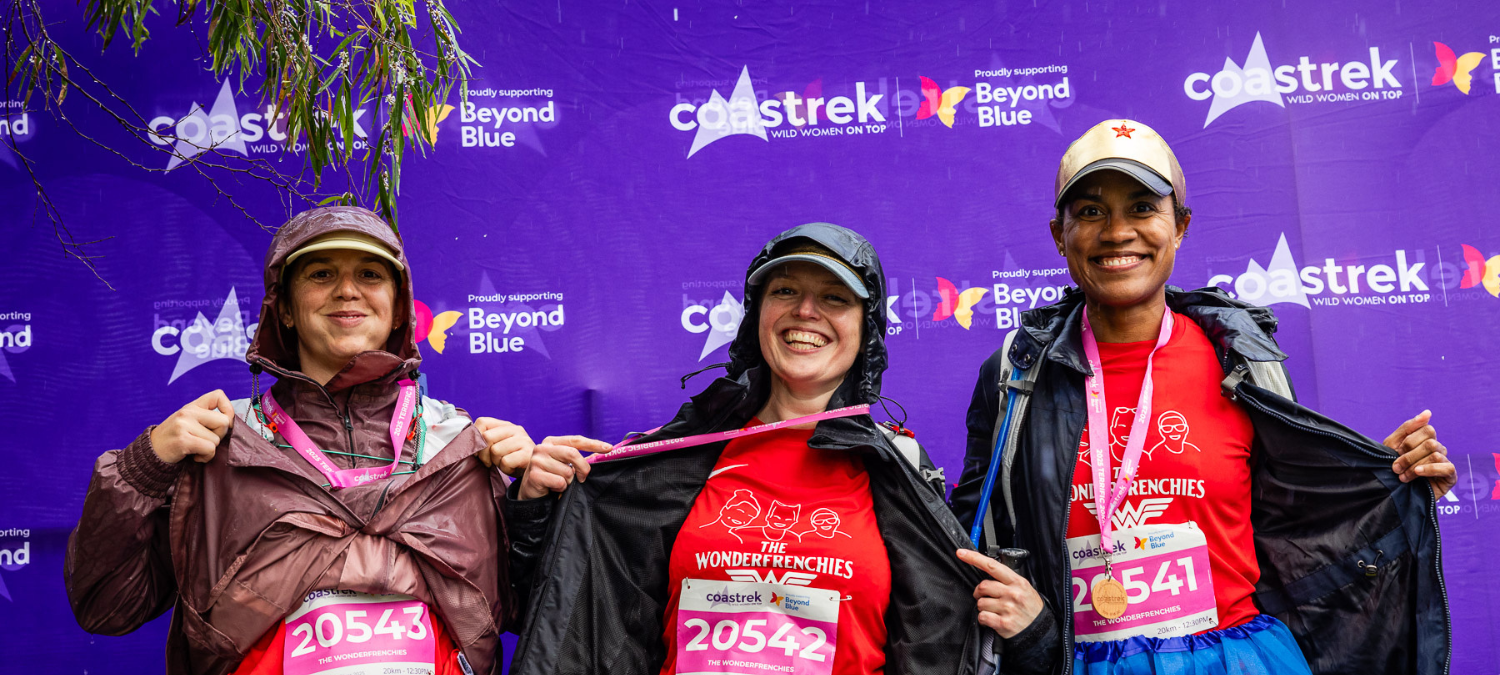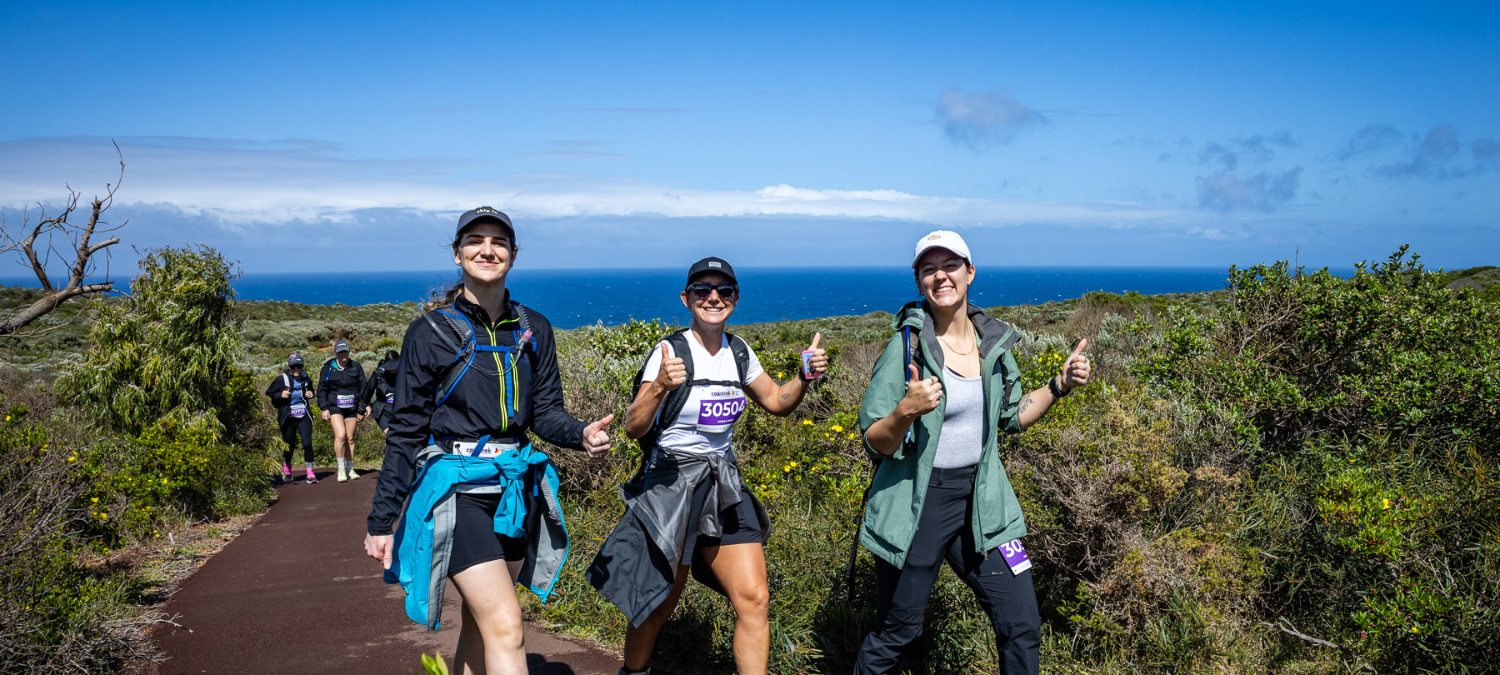Nothing beats endurance walking off the beaten track, but it helps to be prepared for unpredictable hazards and the potential risks they pose – so you can bound over the Coastrek finish line with joy!
Brenniston First Aid specialises in keeping people first aid-ready and safety compliant at work. As a two-time Coastrekker preparing for her third event, owner Pia Abrahams shares some of the most common hazards and risks to endurance walking, and recommends the first aid essentials you shouldn’t leave home without.
What are some ways to manage weather risks on an endurance walk?
Dress in layers, carry good-quality wet-weather gear with a hood and include a beanie if walking past daylight.
What should you do if you get really cold?
Getting a bit cold is no big deal, but being too cold for too long can lead to hypothermia - a dangerous drop in body temperature caused by prolonged exposure to cold temperatures.
Indications of hypothermia:
Initial shivering, followed by poor co-ordination, lethargy, slurred speech and slow or irregular pulse with possible loss of consciousness.
What to do:
- Shelter or gently move the person away from exposed weather conditions.
- Remove wet clothing only if weather-protected.
- Wrap them in a thermal shock blanket or any dry clothing available, ensuring protection from the wet ground.
- Cover their head to prevent further heat loss.
- Give a warm (not hot) drink if available.
- Keep them warm and monitor consciousness until medical assistance arrives.
- If they lose consciousness, place in recovery position, and follow DRSABCD.
What should you do if you get very hot?
There are two risks associated with heat – heat exhaustion and heat stroke.
Heat Exhaustion is caused by dehydration.
Indications of heat exhaustion:
Lower-leg cramps, thirst, exhaustion, weakness, nausea, vomiting, dizziness, pale clammy skin, rapid weak pulse and rapid breath.
What to do:
- Lie the person down in a cool area, loosening tight clothing at neck and waist.
- Raise their legs slightly.
- If alert and conscious, give frequent sips of water. No salt.
- If semi-conscious or unconscious, place in recovery position and follow DRSABCD.
Heat Stroke is a potentially fatal response to the body severely overheating after prolonged exposure to high temperatures.
Indications of heat stroke:
High body temperature, flushed and dry skin, confusion, irritability, seizure, unconsciousness.
What to do:
- Call Triple Zero for an ambulance.
- Apply ice packs or wet towels to the person’s armpits and groin, cover them with a wet sheet/clothing.
- If semi-conscious or unconscious, place in recovery position and follow DRSABCD.
What should you do if you get sand in your eyes?
We’ve all been at the beach and had a gust of wind hit us with a face full of sand. During Coastrek, you’ll be walking along lots of beaches, so it’s handy to know sand-eye first aid.
Indications of sand in eyes:
Red, irritated eye, constant tears, pain, reduced or altered vision.
What to do:
- Wait until the sand/grit is clear of the cornea (front surface of the eye).
- Use saline eyewash to repeatedly flush the eye and under the eye lid.
- If the object remains, use a clean, moistened cloth to carefully remove it from the corner or under the lid.
Note: Saline ampoules are ideal for flushing eyes, as their stream can be directed straight into the corner of the eye, or under the lid.
What should you do if you sprain your ankle?
A sprain is an injury to ligament and soft tissue surrounding a joint, and is probably the most common injury on Coastrek.
Indications of a sprain:
Intense pain, restricted movement, rapid swelling, bruising, shock.
A strain is a torn or over-stretched muscle or tendon e.g. groin or hamstring.
Indications of a strain:
Sharp and sudden pain, muscular tenderness, reduced functionality, shock.
What to do (sprains and strains):
Follow the R-I-C-E-R method:
R-est the person and their injury completely.
I-ce the injured area in a wrapped ice pack for 15 mins every two hrs for 24 hrs.
C-ompression bandage firmly and evenly around the injured area to reduce swelling and bruising.
E-levate the injured limb, cushioning the affected area. If in shock, lie the person down, cover in a thermal shock blanket with both legs raised if possible.
R-efer for medical assistance, including an ambulance if the person remains in shock, is in severe pain or unable to be transported.
What should you do if you get a scrape or abrasion?
An abrasion is a minor open wound, such as a scrape or graze.
Indications of an abrasion:
Surface layers of thin skin are broken, scraped or grazed, usually on knees, ankles or elbows.
What to do:
- Apply pressure to the wound with a clean dressing or cloth to slow down bleeding.
- If bleeding heavily, elevate the limb above the heart and continue pressure for 5 minutes.
- Once bleeding has stopped, rinse the wound and any embedded debris with water, saline or an antiseptic cleansing wipe, pat dry and apply a sterile dressing (e.g. adhesive dressing strip, or a dressing pad secured with tape or bandage).
- If a foreign object is protruding from the wound (e.g. a stick, gravel etc.), don’t try to remove it - apply pressure and padding around the object and seek medical assistance as soon as possible.
If you’ve signed up for Coastrek – whether it’s the 30km, 45km or 60km event – you’re in for an unforgettable experience that will challenge, exhilarate and inspire you to do more. Preparation is the key to a safe and successful walk; identify the potential hazards, anticipate the risks and don’t leave home without your first aid essentials in a compact, easily accessed first aid kit.
Brenniston First Aid is a proud supporter of Coastrek.






